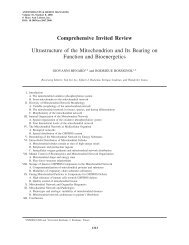MiPsummer Programme pdf - Mitochondrial Physiology Society
MiPsummer Programme pdf - Mitochondrial Physiology Society
MiPsummer Programme pdf - Mitochondrial Physiology Society
You also want an ePaper? Increase the reach of your titles
YUMPU automatically turns print PDFs into web optimized ePapers that Google loves.
82<br />
Abstract # 50<br />
MITOCHONDRIAL CARRIER PROTEINS IN FATTY ACID ACTIVATED UNCOUPLING<br />
IN DIFFERENT TISSUES OF HIBERNATING GROUND SQUIRRELS<br />
Komelina N.P., Amerkhanov Z.G.<br />
Institute of Cell Biophysics Russian Academy of Science, Pushchino, Russia.<br />
Background.<br />
Fatty acid - induced uncoupling of mitochondria is known to be mediated by some anion carriers, as<br />
uncoupling proteins (UCPs), adenine nucleotide translocase (ANT) and aspartate/glutamate<br />
antiporter. Well-studied UCP1 in brown fat produce heat using this mechanism. UCP1 activity is<br />
tightly regulated, being inhibited by purine nucleotides and activated by free fatty acids. It is<br />
supposed that similar properties are inherent in UCP2 and UCP3 homologues in different tissues.<br />
ANT is also involved in the fatty acid-induced uncoupling and responsible for the major part of the<br />
thermoregulatory uncoupling in heart- and skeletal- muscle mitochondria of cold-exposure rats and<br />
hibernating ground squirrels.<br />
Objectives.<br />
The aim of our investigation was to reveal functional activity of UCP2 and UCP3 using recoupling<br />
effect of purine nucleotides and to differentiate them from the contribution of ANT in the uncoupling<br />
using its high-specific inhibitor - carboxyatractylate.<br />
Methods.<br />
We measured respiration rate of mitochondria in the presence of oligomycin and rotenone under<br />
addition of 100µM laurate. We tried different order of additions of inhibitors to demonstrate their<br />
independent effects. We used recoupling effect of GDP to indicate activity of UCP3 in skeletal<br />
muscle and UCP2 in lung and spleen of long-tailed hibernating ground squirrels. Mitochondria of<br />
liver were taken as negative control, since there are no any UCPs at significant level. Hibernating<br />
ground squirrels as the object ensured increased level of all UCPs during winter season.<br />
Results.<br />
We found that GDP in millimolar concentrations had<br />
a slight recoupling effect on respiration rate and<br />
membrane potential in all studied mitochondria of<br />
hibernating ground squirrels, including skeletal<br />
muscle, lung, spleen and liver mitochondria.<br />
However, GDP had no effect, if carboxyatractylate in<br />
micromolar concentration was added previously. No<br />
crucial differences were found in compare to liver<br />
mitochondria. At the same time, evident and<br />
independent recoupling effect of glutamate before as<br />
well as after carboxyatractylate, demonstrate activity<br />
of aspartate/glutamate antiporter in fatty acid –<br />
induced uncoupling.<br />
Conclusion.<br />
We concluded that recoupling effect of purine nucleotides in skeletal muscle, lung, spleen and liver<br />
mitochondria of hibernating ground squirrels can be explained by their interaction with ANT rather<br />
then by functioning of UCP2 and UCP3.<br />
Acknowledgments.<br />
This work was partly supported by the Program ‘Integration of Molecular Systems in Physiological Functions’ of the<br />
Russian Academy of Sciences and grant 12-04-31326 from the Russian Fund for Basic Research.



